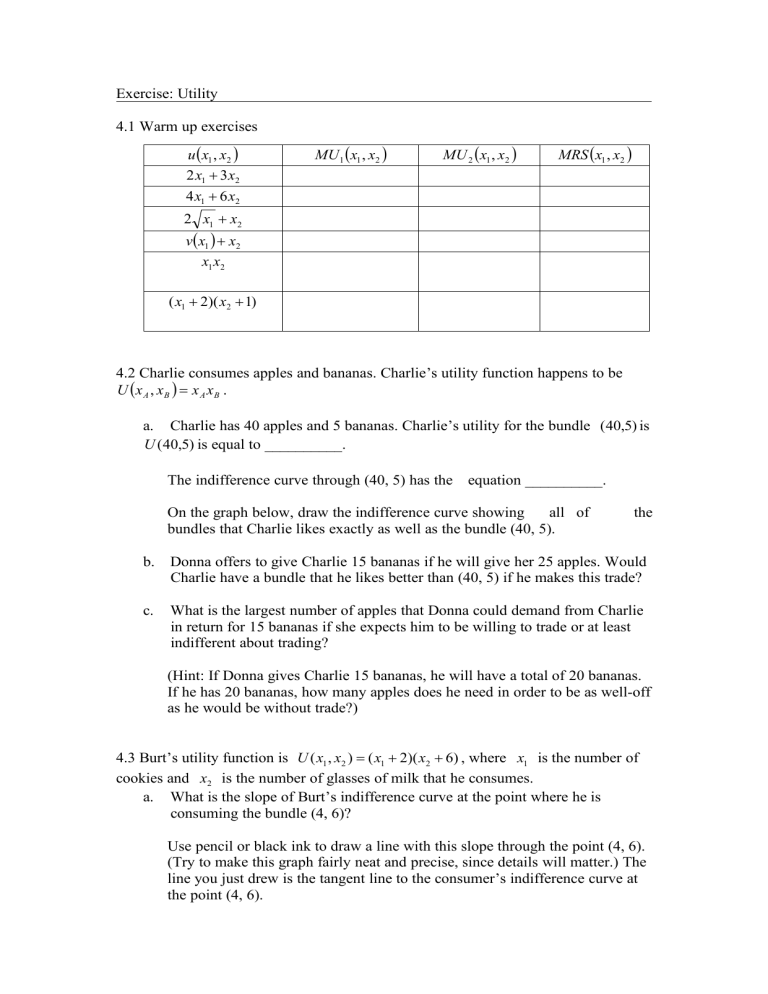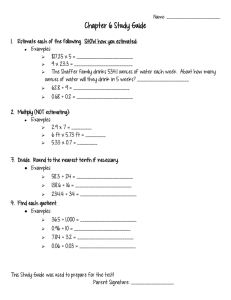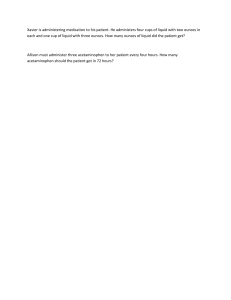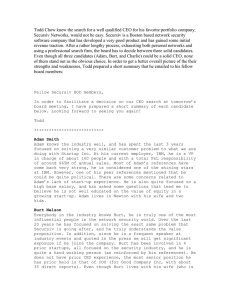
Exercise: Utility 4.1 Warm up exercises u x1 , x2 2 x1 3 x2 4 x1 6 x2 MU 1 x1 , x2 MU 2 x1 , x2 MRS x1 , x2 2 x1 x2 v x1 x2 x1 x2 ( x1 2)( x2 1) 4.2 Charlie consumes apples and bananas. Charlie’s utility function happens to be U x A , xB x A xB . a. Charlie has 40 apples and 5 bananas. Charlie’s utility for the bundle (40,5) is U (40,5) is equal to __________. The indifference curve through (40, 5) has the equation __________. On the graph below, draw the indifference curve showing all of bundles that Charlie likes exactly as well as the bundle (40, 5). the b. Donna offers to give Charlie 15 bananas if he will give her 25 apples. Would Charlie have a bundle that he likes better than (40, 5) if he makes this trade? c. What is the largest number of apples that Donna could demand from Charlie in return for 15 bananas if she expects him to be willing to trade or at least indifferent about trading? (Hint: If Donna gives Charlie 15 bananas, he will have a total of 20 bananas. If he has 20 bananas, how many apples does he need in order to be as well-off as he would be without trade?) 4.3 Burt’s utility function is U ( x1 , x2 ) ( x1 2)( x2 6) , where x1 is the number of cookies and x2 is the number of glasses of milk that he consumes. a. What is the slope of Burt’s indifference curve at the point where he is consuming the bundle (4, 6)? Use pencil or black ink to draw a line with this slope through the point (4, 6). (Try to make this graph fairly neat and precise, since details will matter.) The line you just drew is the tangent line to the consumer’s indifference curve at the point (4, 6). b. The indifference curve through the point (4, 6) passes through the points ( 10 ,0), (7, 2 ), and (2, 12 ). Incidentally, the equation for Burt’s indifference curve through the point (4, 6) is __________. c. Burt currently has the bundle (4, 6). Ernie offers to give Burt 9 glasses of milk if Burt will give Ernie 3 cookies. If Burt makes this trade, he would have the bundle __________. Burt refuses to trade. Was this a wise decision? Mark the bundle on your graph. __________. d. Ernie says to Burt, “Burt, your marginal rate of substitution is 2. That means that an extra cookie is worth only twice as much to you as an extra glass of milk. I offered to give you 3 glasses of milk for every cookie you give me. If I offer to give you more than your marginal rate of substitution, then you should want to trade with me.” Burt replies, “Ernie, you are right that my marginal rate of substitution is -2. That means that I am willing to make small trades where I get more than 2 glasses of milk for every cookie I give you, but 9 glasses of milk for 3 cookies is too big a trade. My indifference curves are not straight lines, you see.” e. Would Burt be willing to give up 1 cookie for 3 glasses of milk?__________. Would Burt object to giving up 2 cookies for 6 glasses of milk? __________. ab , 100 where a is the number of ounces of animal crackers that she consumes and b is the number of ounces of beans that she consumes. a. On the graph below, sketch the locus of points that Martha finds indifferent to having 8 ounces of animal crackers and 2 ounces of beans. 4.4 Martha Modest has preferences represented by the utility function U (a, b) Also sketch the locus of points that she finds indifferent to having 6 ounces of animal crackers and 4 ounces of beans. b. Bertha Brassy has preferences represented by the utility function V (a, b) 1,000a 2b 2 , where a is the number of ounces of animal crackers that she consumes and b is the number of ounces of beans that she consumes. On the graph below, sketch the locus of points that Bertha finds indifferent to having 8 ounces of animal crackers and 2 ounces of beans. Also sketch the locus of points that she finds indifferent to having 6 ounces of animal crackers and 4 ounces of beans. c. Are Martha’s preferences convex? Are Bertha’s? d. What can you say about the difference between the indifference curves you drew for Bertha and those you drew for Martha? e. How could you tell this was going to happen without having to draw the curves? 4.5 Joe Bob has a utility function given by u ( x1 , x2 ) x12 2 x1 x2 x22 . a. Compute Joe Bob’s marginal rate of substitution: __________. b. Joe Bob’s straight cousin, Al, has a utility function v( x1 , x2 ) x2 x1 . Compute Al’s marginal rate of substitution.__________. c. d. Do u ( x1 , x2 ) and v( x1 , x2 ) represent the same preferences? Can you show that Joe Bob’s utility function is a monotonic transformation of Al’s? (Hint: Some have said that Joe Bob is square.) __________. 4.6 Willy Wheeler’s preferences over bundles that contain nonnegative amounts of x1 and x2 are represented by the utility function U x1 , x2 x12 x22 . a. Draw a few of his indifference curves. What kind of geometric figure are they? __________. Does Willy have convex preferences? Reference: Bergstrom, T. C., & Varian, H. R. (2014). Workouts in Intermediate Microeconomics: A Modern Approach. New York: W.W. Norton & Co.




